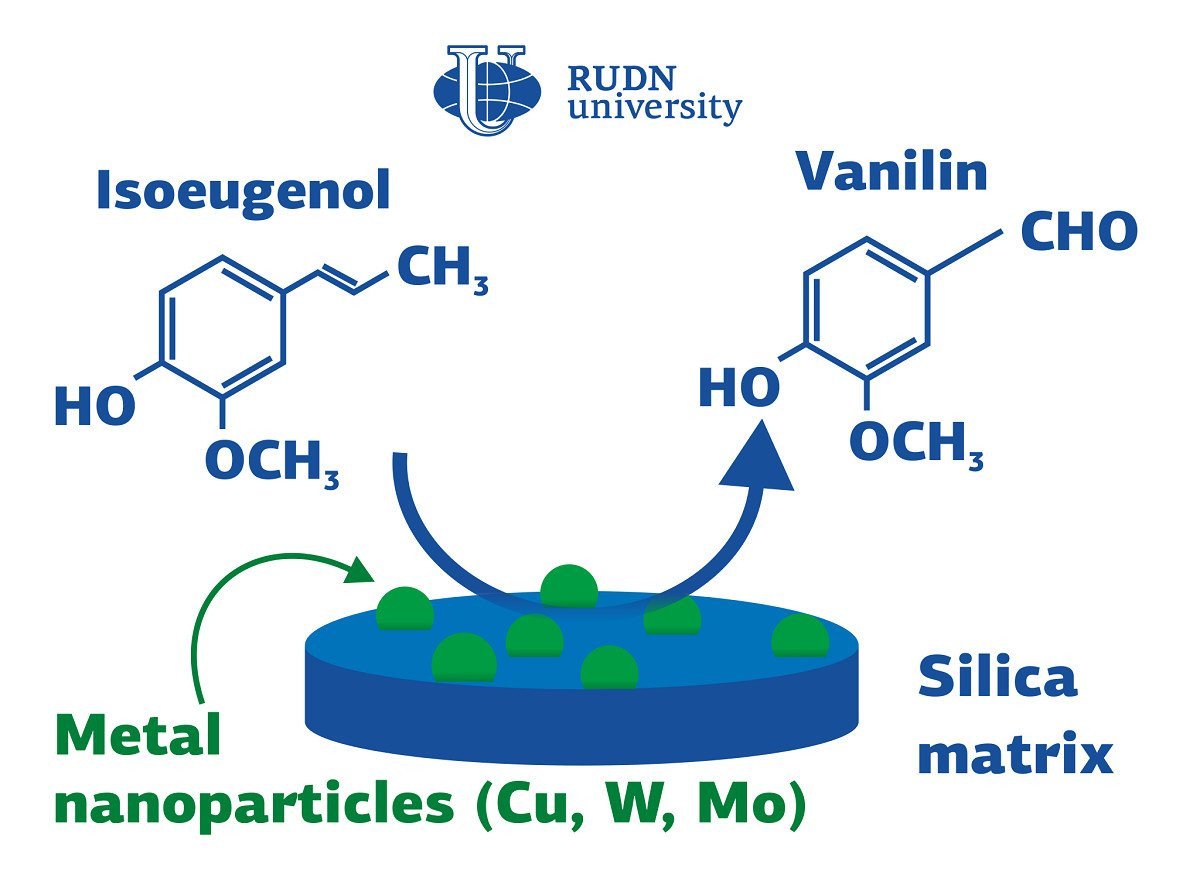RUDN University chemist creates nanocatalysts for vanillin synthesis

Only 1% of the annually produced worldwide 20 thousand tons of vanillin is made from natural vanilla. Almost all vanillin in seasonings, pastries, pharmaceuticals and cosmetics is synthesized by chemical protocols. Usually, petrochemical raw materials are used for this, but synthesis from inexpensive plant biomass is also possible. The main ingredient is lignin. This polymer is widely available as it is part of the trees, and it is obtained in the production of paper as a by-product. It is easy to isolate eugenol and other substances suitable for the synthesis of vanillin from lignin, but the next step is challenging. In oxidation reactions, along with vanillin, several by-products similar to it in structure are formed. It is difficult to separate them. The RUDN University chemist proposed a number of eco-friendly nanocatalysts that will allow obtaining more vanillin from plant raw materials than traditional methods.
“For many years, the chemical industry has been interested in new catalysts to increase the economic efficiency of production. Today, catalysts that allow switching to more environmentally friendly methods of chemical synthesis are in demand. The higher their catalytic activity, the milder the conditions in which we can apply them. This is a chance to reduce energy costs and the burden on the environment”, said Prof. Rafael Luque from the Joint Institute for Chemical Research, RUDN University.
To create an effective catalyst, the RUDN chemist used the advantages of nanostructured materials. The smaller pores and channels per unit volume of the catalyst, the larger the surface with which chemicals can interact during the reaction. But the active nanoparticles must be securely bound to this surface so as not to be washed out at the first use of the catalyst. The solution was found in the combination of substances of different classes: silicon base and metal nanoparticles. To do this, a metal salt and tetraethoxysilane (a precursor of silicon dioxide) were mixed in a solvent and the mixture was exposed to microwaves at a temperature of 80-100°C for several minutes. In a series of experiments, different metals were used: copper, niobium, molybdenum, and tungsten. All the materials turned out to be highly porous after drying. Microwaves caused the formation of nanotubes in them. Additional studies have shown that metal nanoparticles are embedded in the silicon matrix.
All the obtained catalysts were tested in the reaction of oxidation of isoeugenol with hydrogen peroxide. The reagents were combined in a solvent at a temperature of 80°C for 6 hours. During this time, all materials, except for the catalyst with molybdenum, provided the processing of more than 50% of isoeugenol. But the high selectivity with respect to vanillin, that is, the production of the largest proportion of this substance, was provided only by a catalyst with copper. In his case, 88% of the reaction products were vanillin.
“The synthesized catalysts possess a significant potential as catalyst in the wet oxidation of isoeugenol to vanillin. One of the obtained materials with the inclusion of copper showed significantly higher selectivity than previously known catalysts. As repeated reactions have shown, this catalyst can be used up to four times without significant loss of efficiency”, said Prof. Rafael Luque from the Joint Institute for Chemical Research, RUDN University.
The results of the study are published in Molecular Catalysis.
RUDN summarized the results of the scientific competition "Project Start: work of the science club ". Students of the Faculty of Physics, Mathematics and Natural Sciences have created a project for a managed queuing system using a neural network to redistribute resources between 5G segments. How to increase flexibility, make the network fast and inexpensive and reach more users — tell Gebrial Ibram Esam Zekri ("Fundamental Computer Science and Information Technology", Master's degree, II course) and Ksenia Leontieva ("Applied Mathematics and Computer Science", Master's degree, I course).
The National Demographic Report, 2023 Demographic Well-Being of Russian Regions (hereinafter - the National Demographic Report) was prepared by the scientific team of the Institute of Demographic Studies of the Federal Research Center of the Russian Academy of Sciences, the Vologda Scientific Center of the Russian Academy of Sciences, Peoples' Friendship University of Russia, the Center for Family and Demography of the Academy of Sciences of the Republic of Tatarstan, as well as with the participation of leading scientists from the Republic of Bashkortostan, Stavropol Krai, Volgograd, Ivanovo, Kaliningrad, Nizhny Novgorod, Sverdlovsk Oblasts and Khanty-Mansi Autonomous Okrug–Yugra.
RUDN summarized the results of the scientific competition "Project Start: work of the science club ". Students of the Faculty of Physics, Mathematics and Natural Sciences have created a project for a managed queuing system using a neural network to redistribute resources between 5G segments. How to increase flexibility, make the network fast and inexpensive and reach more users — tell Gebrial Ibram Esam Zekri ("Fundamental Computer Science and Information Technology", Master's degree, II course) and Ksenia Leontieva ("Applied Mathematics and Computer Science", Master's degree, I course).
What is your first association with the word “laboratory”? Flasks and beakers? Microscopes and centrifuges? Yes, many of us would answer the same way.
The National Demographic Report, 2023 Demographic Well-Being of Russian Regions (hereinafter - the National Demographic Report) was prepared by the scientific team of the Institute of Demographic Studies of the Federal Research Center of the Russian Academy of Sciences, the Vologda Scientific Center of the Russian Academy of Sciences, Peoples' Friendship University of Russia, the Center for Family and Demography of the Academy of Sciences of the Republic of Tatarstan, as well as with the participation of leading scientists from the Republic of Bashkortostan, Stavropol Krai, Volgograd, Ivanovo, Kaliningrad, Nizhny Novgorod, Sverdlovsk Oblasts and Khanty-Mansi Autonomous Okrug–Yugra.